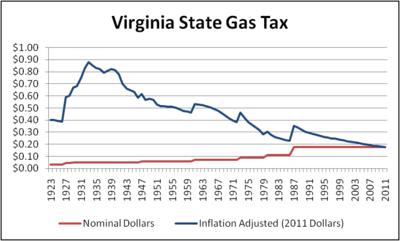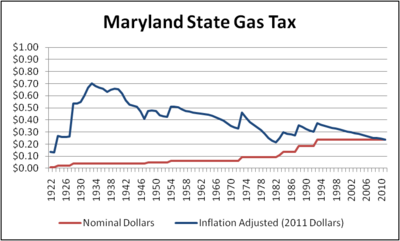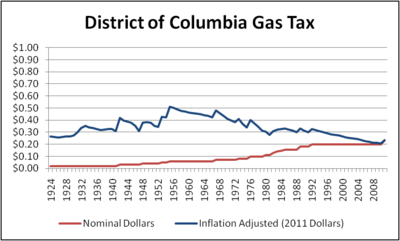Inflation, not bike sharing, is why the gas tax isn’t enough
Congressman Eric Cantor (R-VA) recently railed against urban bike sharing, blaming it, pedestrian funding, and more for the gas tax not covering all transportation needs. But the real problem is that the gas tax is bringing in less revenue than in the past.
Virginia, Maryland, and DC are also raising record low amounts of revenue, adjusted for inflation, compared to almost any time in the history of their gas taxes.
Cantor says that federal bicycle and pedestrian funding in FY 2011 was around $1 billion. He claims that we spent $53 billion on highway and transit projects, which are the only types of transportation projects he considers appropriate. That means we spent 1.85% of our transportation budget on bikes and peds.
Unfortunately, the gap in our transportation budget is much larger than $1 billion.
The actual problem with the highway and transit trust funds is inflation. The federal gas tax was last raised in 1993. And since a penny buys less every year, so does the gas tax.
The federal motor fuel tax rate is currently 18.4¢ per gallon. That’s the highest it’s ever been in nominal dollars. But if we adjust for inflation, we see that in January 1994, 18.4¢ was worth 28¢ in 2011 dollars. That’s a reduction of 34% in the value of the tax.
In actual buying power, the high point of the federal gas tax was in 1960. That year, the rate was just 4¢ (raised from 3¢ in 1959). But if we adjust for inflation, we find that 4¢ in 1960 is equal to 31¢ today.
In fact, at present we’re on the cusp of dropping below the value of the gas tax when it was implemented in 1932. That year it was just one penny per gallon, which translates to 16.7¢ in today’s dollars. That’s not much less than the 18.4¢ we pay now.
In Cantor’s home state, Virginia, the trend is even more stark. The gas tax is bringing in less money than at any time since the Commonwealth instituted the tax in 1923.
Back then, Virginia drivers had to pay a whopping 3¢ on each gallon of gasoline. But three pennies in 1923 is the equivalent of 40¢ today. That alone is more than today’s Virginia and federal gas taxes combined, which add to 35.9¢/gallon.
Like the federal tax, the buying value of Virginia’s state motor fuel tax has declined almost steadily since its peak in 1933, when it was at 87.8¢ in 2011 dollars (a nickel in 1933 dollars). It was last raised in 1987, when it went from 11¢ per gallon to 17.5¢ per gallon (raised from 22¢ to 35¢ in 2011 dollars). Due to inflation, Virginia’s gas tax has lost 50% of its value over the last 24 years, and is now lower than ever before.
This is a difficult concept for many people to understand, at least in the abstract. That makes it easy for people to accidentally or purposefully mislead with figures. Consider the position of the Virginia Petroleum, Convenience and Grocery Association, the industry group representing many convenience stores in the state:
Whereas, In 1987, the first full year after Virginia’s motor fuel taxes were last increased, the state collected $468 million. For 2009 motor fuel tax collections were $904 million, an increase of 93.1 percent; … Now Therefore Be It Resolved, … VPCGA opposes any effort to expand local motor fuel taxation, as well as any effort to increase the rate of the existing local taxes…
Did you see what VPCGA did there? They looked at the revenues from 1987 and the revenues from 2009 and compared them directly. But a 1987 dollar is not equivalent to a 2009 dollar. It is intellectually dishonest to suggest that tax collections increased by 93%.
If we adjust the 1987 gas tax revenue to 2009 dollars we can make a more valid comparison. $468 million in 1987 would be a touch over $872 million in 2009 dollars. That means that the 2009 revenue of $904 million is only a 3.67% increase over the 1987 revenue.
Another problem with gas tax revenues is the growth in Vehicle Miles Traveled (VMT). VMT growth is outstripping growth in gas tax revenues. This is due somewhat to an increase in gas mileage. In Virgina, VMT increased from 54.8 billion in 1987 to 80.9 billion in 2009. That’s a VMT increase of 48%, while motor fuel tax revenues increased by less than 4% (inflation adjusted) over the same period. This means that people are driving a lot more without paying the correspondingly higher taxes that would be needed to keep the transportation system fully funded.
Like the rest of the country, Virginia is facing ever greater demand for all modes of transportation, but it has not raised the primary tax funding these programs in 24 years. And in fact, due to inflation, that tax’s value has been dropping.
The other jurisdictions in the region face the same issues.
Maryland last raised its gas tax in 1992. It’s been declining ever since in inflation-adjusted dollars. The current tax of 23.5¢ was worth 37¢ of 2011 buying power in 1993. The high point for Maryland’s gas tax was in 1933, when the 4-penny tax was worth 70¢ in 2011 dollars.
The District just raised its gas tax by 3.5¢ to match Maryland’s, from 20¢ to 23.5¢. DC hit its peak in 1955, when its 6¢ tax was worth 51¢ in 2011 dollars.
Raising taxes is a hard proposition for many politicians these days, but if we’re going to keep our transportation infrastructure competitive then we need to find new revenues. The gas tax may be all or part of the solution, and it is overdue to be raised.
It’s been over 700 days since the transportation bill (SAFETEA-LU) expired. It’s been extended 7 times since then. It’s now set to expire on the 30th of this month. If Congress lets the extension expire, the federal gas tax will stop. So will construction projects and grants all over the country.
We need a new bill, not just an extension. And this bill needs to be more progressive than the last one. We need a bill that encourages complete streets, recognizes the ability of livable communities to affect transportation demand, and one that gives states and regions more flexibility to decide the best course.
But the only way we’ll be able to catch up on our decaying infrastructure and prepare for the future is to deal with the decline of the value of the gas tax. Now that Congress is back in session, it’s time to deal with this mess.
If our elected officials do decide to raise the gas tax, one way to stop continued inflationary slide in its value would be to make it a sales tax rather than an excise tax. So, instead of charging a tax each gallon, the tax could be levied on each dollar spent on gasoline.
Whatever the solution is, it won’t be found merely by cutting bikesharing programs, even if that does make a good soundbite in Mr. Cantor’s district.




